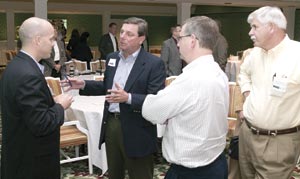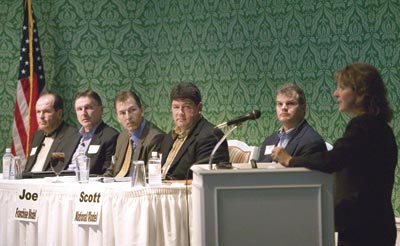Perpetuation matters Agents of Westfield Insurance get a big boost in planning for the future By Elisabeth Boone, CPCU
A company that’s been in business since 1848 knows a lot about perpetuation. At Westfield Insurance of Westfield Center, Ohio, an essential element of longevity is building strong, mutually beneficial relationships with independent agents. Westfield goes beyond lip service to deliver a powerful package of tools to the 1,200 agents who represent the company in its 26-state territory. Westfield’s team assists its agencies at no cost in virtually all aspects of perpetuation. The team’s services encompass several areas of expertise, including legal, accounting, taxes, financing, banking, and marketing. The team works closely with Marsh, Berry & Co.; Mystic Capital; and Reagan & Associates—outside specialists in arranging agency sales and mergers. Westfield Bank, a member of Westfield Group, specializes in assisting the insurer’s independent agency partners with their banking and financing needs, including perpetuation needs. One important way that Westfield helps its agents deal with the issue of perpetuation is its sponsorship of its INSIGHT conference, a one-day event at which agents learn from an outside consultant and share their successful perpetuation strategies. Last year Westfield hosted three INSIGHT conferences: two at its home office just outside Cleveland, and a third in Harrisburg, Pennsylvania. (The company plans four INSIGHT conferences in 2006.) Early last November, agency partners from around Ohio gathered at Westfield’s Blair Conference Center, where the keynote speaker was Kevin Donoghue, managing partner of Mystic Capital, a financial services consulting company. His experience includes agency valuation, negotiation, and funding mechanisms and options. Donoghue offered plain talk about perpetuation, addressing both general trends and must-know details. Know your options In contemplating perpetuation, Donoghue said, “The key is to know there are alternatives. I’m amazed at agents’ lack of understanding of their options.” For starters, he advised, “Don’t just look inside; look outside.” To underline this point, Donoghue defined perpetuation as “selling an existing ownership stake to someone inside or outside the agency—not just inside.” Perpetuation involves the succession of the business, he noted, and it doesn’t necessarily mean a 100% sale. The right time A frequently asked question for agency principals is: When is the right time to perpetuate? “The right time to start planning for perpetuation is the second you purchase your shares,” Donoghue asserted. “You should allow at least three years for the transition of your book to a new owner.” Perpetuation should be planned to take place on the owner’s timetable, he said. Among the factors to consider are the age of the shareholder, the strength of the agency’s “internal bench,” insurance market pressures, and years to retirement. “Don’t be forced to sell due to age, markets, or lack of employee talent,” he urged. “Actively manage your destiny!” Knowing you always have the option of selling your agency, Donoghue said, “Start implementing value-enhancing measures ASAP. Build something that is wanted!” Whether or not you’re currently seeking a buyer for your ownership interest, Donoghue said, “Understand how agencies are valued. The primary driver of agency value is cash flow. Don’t believe consultants who say ‘Agencies should sell for two and a half times revenue,’” he advised. “It’s a ploy to get you to retain the consultant.” A look at the market for agencies and brokerages, Donoghue said, shows that “acquisition is a key growth factor for regionals and publicly traded brokers.” He added, however, that “pricing seems to be topping out, and the market is becoming soft.” Next, he observed, “The bank craze has slowed dramatically. Banks have become more mature buyers, and their acquisition process is more focused. Some banks that bought agencies have sold them back.”
What affects value? The value of an agency is influenced by a host of factors, Donoghue said, adding, “Valuation is not an exact science.” He identified 10 factors and commented on each item. 1. EBITA (Earnings Before Taxes, Interest, and Amortiza-tion)—“The higher the EBITA margin, the higher the agency’s value.” When calculating an agency’s value on EBITA versus revenue, “The multiple is usually between 5 and 6.5.” Thanks to the Spitzer investigations of mega-brokers, Donoghue pointed out, “Contingency commissions are almost gone from major brokers. As an agency, you can normalize your contingency income over the last two years. Some agencies don’t count contingency income because it’s not guaranteed or sustainable.” 2. Business structure—Is the agency a C corporation or an S corporation? “C corporations on an EBITA basis are worth less than S corporations because of tax laws. The differential is at least 25%. C corporations kill deals. In an internal acquisition, whether you’re a C corporation or an S corporation doesn’t matter, but it’s best to convert to an S corporation to prepare for the future. It can take 10 years to unwind a C corporation. Don’t panic; start now.” 3. Employment agreements—“If you don’t own it, you can’t sell it. Employment agreements are one of the soundest proofs of ownership.” When a producer’s employment agreement contains a vesting or deferred compensation clause, “that gives the producer ownership rights.” When it comes to support staffers, “Treat them as if they could become key employees”—in other words, have them sign an employment agreement. 4. Concentration risks—Assess your lines of business or products, customer base, markets, geographic region, producer staff. “If too much of your business is in too few accounts, your agency is worth less to a buyer. The more lines of business and the more products you offer, the better.” 5. Market, competitors, and trends—Conduct a trend analysis of your market, products, and historical performance. Analyze your competitors. 6. Key personnel—Who runs the agency … sales … operations? “Not all owners run the business; it may be run by a key employee.” As a seller, “Should I stay or should I go?” A key issue is compensation. “Compensation is determined by the market, not by the agency owner. The buyer doesn’t look at employees’ compensation the same way as you do, and may not want to pay them as much. View your agency through the lens of the buyer.” 7. Intangibles and premiums—“Blood, sweat, and tears”—the time and effort you’ve invested in building your agency. Cross-selling and synergies: “In the early to mid-1990s, banks saw cross-selling opportunities in personal lines, so they paid a premium to buy agencies. The cross-selling synergy wasn’t there; the average is 5%, not 50% as banks envisioned. The same thing happened with commercial lines agencies.” Another perceived premium is expertise. 8. Tangible balance sheet—Consider your net tangible worth. Unlike asset sales, “stock deals assume the balance sheet, including both stated and unstated obligations.” With respect to working capital, “Be specific in an asset deal.” 9. Methodologies—In preparing to sell your agency, decide whether you will use an asset, income, or market approach. Consider discounted future cash flows and after-tax effects. 10. Risk/reward-deal structure—When an agency is sold with cash up front, the seller receives a lower multiple. In an earn-out deal with no cash up front, the seller gets a higher multiple. “For agencies with revenue under $1 million, an earn-out is often preferable. Agencies with revenue of over $5 million are usually sold for a fixed price. Most deals are a combination of earn-out and cash.” Donoghue’s final piece of advice to agents: “Be sure the representations you make are accurate and verifiable. If your disclosures are honest, the buyer has no cause to renegotiate the terms of the deal.”
Five models Donoghue’s presentation was followed by a panel discussion that featured five Westfield agents, each of whom uses a different approach to perpetuation. Local agency model presented by Tom Wichert, president of Wichert Insurance Services, Inc., Cuyahoga Falls, Ohio. Now in its fourth generation of family ownership, Wichert owns six agencies throughout Ohio, employs 50 people, and has completed 14 acquisitions. “We are not a cluster or a franchise,” Wichert said, “and we’re not always a majority owner. We become the general or managing partner in each location.” In evaluating candidates for acquisition, Wichert looks for existing Westfield agencies that have a long-established identity in the community and have long-time employees who know their clients. An agency must have strong earnings and good loss ratios with its carriers but may not have kept up with automation and may need more markets but lack the volume to get appointed. “We’re not looking for strategic locations; we’re more interested in where an agency stands with its customers,” Wichert said. “We acquire some agencies by paying off their accounts payable. We bought one agency from an estate and another from an owner who was going to jail.” Operational and administrative functions are handled in Wichert’s home office. Each agency has its own name on the front of its building, and all agencies know what is going on with each other’s markets. Regional agency model presented by Mike Sherman, president and chief executive officer of Dawson Companies, Rocky River, Ohio. Ranked the 94th largest broker by Business Insurance, Dawson operates nine locations in Ohio and two in Florida. The company has 205 employees and has completed 18 acquisitions. Dawson requires a 51% interest in each agency it acquires. Financial operations are centralized in one office; another office is responsible for rating and quoting, and a third handles claims. This structure, Sherman noted, lets agencies do what they do best and “get on with the business of writing insurance.” Like Wichert, Dawson wants an acquisition candidate to “be known in the community as a trusted person,” Sherman said. Also important is compatibility. “Do we think about business the same way in terms of ethics, professionalism, and so on?” Dawson focuses on identifying the seller’s objectives with respect to factors like perpetuation, markets, and support. Location is key, Sherman added: “We want an agency that will be a good fit with Dawson. We need a leader at every location.” Bank-owned agency model presented by Terry Morman, Sky Insurance, Inc., Maumee, Ohio. A wholly owned subsidiary of Sky Financial Group, Sky Insurance operates 23 offices in Ohio and Pennsylvania and has completed eight acquisitions. The firm seeks acquisitions within the Sky Bank footprint but may go outside the footprint if the deal is right. Corporate functions (finance, human resources, information technology, operations, marketing/branding, and administration) are centralized at Sky’s headquarters in Maumee. Sky is in the process of developing a common agency management system. “Each office is responsible for day-to-day operations with support from corporate functions,” Morman said. “All acquired agencies adopt the Sky name within an agreed period of time. The selling principal is given an employment agreement of two to five years’ duration depending on the principal’s objectives. An acquired agency enjoys a high degree of autonomy and can focus on providing service to local clients. “To maximize cross-selling opportunities,” Morman continued, “producers partner with bank lenders, private bankers, and trust officers within their region for cross referrals and team selling.” A Sky acquisition candidate must be profitable, with a secure balance sheet and a good product mix; have high internal efficiency ratios; have a strong sales approach; and excel at developing and maintaining relationships with clients and carriers. Competence and employee development are key, and Sky wants the employees of an acquired agency to continue working toward professional designations. A Sky agency enjoys a number of advantages, Morman said, including “broad geographic distribution, high ethics and professionalism, a strong business model, and a focused direction and strategy. “We are a big company with a small-company feel, and we are a dynamic and growing agency consolidator,” he declared. Franchise agency model presented by Joe Joyce, vice president, program division of Keystone Insurers Group, Inc., based in Northumberland, Pennsylvania. Tough times call for smart solutions, a fact that was clear to the owners of four small independent agencies located in central Pennsylvania. The year was 1983, and the principals were concerned about their ability to compete effectively in an extremely soft market. Selling or merging their agencies were unattractive options, so the four principals joined forces and formed Keystone Insurers Group, which today has a footprint of 72 agencies with 110 locations in Pennsylvania. KIG also has 20 agencies in North Carolina and six in Virginia, and is considering expanding into Indiana, Tennessee, and Ohio. Keystone operates two subsidiaries: Keystone Risk Managers and Keystone Financial Services. Its program division creates and markets more than 10 specialty programs that are accessible to partners. Keystone Insurers Group is owned by its partners, and their relationships belong to them, Joyce said. In evaluating candidates, the size of an agency is less important than the integrity of its people. “We look for agencies that have been very successful in the past, with the potential to continue being successful in the future,” he said. Partner agencies retain their identity and can use the automation system of their choice. They are not overly pressured to reach their objectives; Keystone helps them make their plans but doesn’t give them unreachable goals. Keystone tells its agencies: You are no longer an island. You’re in business for yourself but not by yourself.”
National agency model presented by Scott Penny, regional executive vice president of Brown & Brown of Indiana, Inc., whose parent, Brown & Brown, Inc., based in central Florida, operates 143 locations in 33 states and has completed 145 acquisitions. “We take a very disciplined approach to perpetuation,” Penny said. “We try to attract agencies whose culture is similar to ours.” Candidates must be both competent and competitive, and have a strong track record of execution, he emphasized. “People need to be passionate about the business.” The screening of potential candidates is a rigorous process conducted by strong due diligence teams, Penny said, and Brown & Brown’s acquisition committee reviews three deals for every one the company completes. Brown & Brown pays cash for an agency’s assets, offering a down payment of 70% to 90% with a one- to three-year workout. An acquired agency must meet stringent pro forma targets and achieve a 25% pre-tax operating margin by the end of the first year, Penny said. Each location is required to have four departments: marketing, accounting, sales, and services. Agencies make their own decision about which automation system to use. Brown & Brown offers a stock ownership plan in which 77% of employees participate; the company is 10% owned by its employees and agencies. Each local office selects its own markets, Penny noted. “Local people need to make money with local people.” Investment in success Westfield Insurance management readily attributes the lion’s share of the company’s success to its strong commitment to its independent agents. Another way Westfield helps its agents with perpetuation is by offering a four-week course on insurance for new agency producers—teaching basic insurance knowledge as well as sales skills. (See Rough Notes’ November 2004 issue, page 76.) These twice-a-year classes, called TAPP (The Association Perpetuation Plan) motivate new producers, who will some day play a role in their agency’s perpetuation. The TAPP classes, like the November INSIGHT conference, are held at the company’s home office. Dave Critchfield, senior executive for agency relationships and development, sums up the company’s commitment to agency perpetuation assistance this way: “Our goal is to educate our valued agency partners on perpetuation by sharing information and showing them various options in our industry. We see this as a Westfield investment in the success of agency partnerships we value.” * |
||||||||||
| ||||||||||







